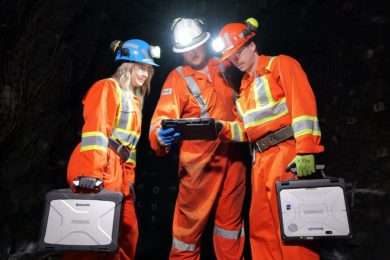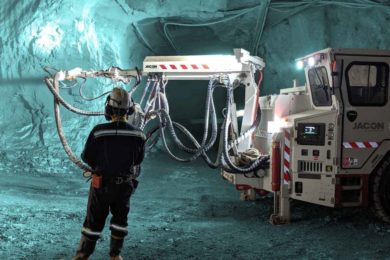 The Murray & Roberts Cementation Training Academy near Carletonville in South Africa has taken the use of simulation combined with the use of other supporting technology to what it says is “the next level.” Underpinned by a battery of learner support programmes, learner trackless mining machine operators are able to progress from a novice status through a series of carefully designed stages that culminate towards operator applied competence. “We recognise that simulation has significant potential beyond what it is typically used for and we intend to fully exploit this potential,” Tony Pretorius, Risk Manager at the Murray & Roberts Cementation Training Academy, says. “Beyond purely training, we make use of simulation for pre-employment screening, learner diagnostic assessment, accident/incident reconciliation, enhancement of psychomotor skills, operator proficiency charting and engineering design. As part of our long term strategy, we intend to include simulation to support mine design and to use it to role-play incidents and accidents that have occurred in the past in the workplace to ensure that we continue mining by lessons learned.”
The Murray & Roberts Cementation Training Academy near Carletonville in South Africa has taken the use of simulation combined with the use of other supporting technology to what it says is “the next level.” Underpinned by a battery of learner support programmes, learner trackless mining machine operators are able to progress from a novice status through a series of carefully designed stages that culminate towards operator applied competence. “We recognise that simulation has significant potential beyond what it is typically used for and we intend to fully exploit this potential,” Tony Pretorius, Risk Manager at the Murray & Roberts Cementation Training Academy, says. “Beyond purely training, we make use of simulation for pre-employment screening, learner diagnostic assessment, accident/incident reconciliation, enhancement of psychomotor skills, operator proficiency charting and engineering design. As part of our long term strategy, we intend to include simulation to support mine design and to use it to role-play incidents and accidents that have occurred in the past in the workplace to ensure that we continue mining by lessons learned.”
The Training Academy is also looking at more projects focussed around trackless mining, recognising that simulation is a powerful tool to accelerate the competency journey of an operator: “It accurately tests learner proficiencies across three areas namely; health & safety, productivity enhancement and machine appreciation in that the associated examples test reflexive competencies through the simulation of common workplace and work related hazards and risks in a virtual environment at a fraction of conventional training related costs.”
Learner training at the Murray & Roberts Cementation Training Academy begins with a PC-based e-learning programme developed from OEM information relating to specific machinery and actual video footage of this machinery in action. This combination of literature, diagrams and video imagery lays down the first level of foundational competence — knowledge and understanding. The learner then proceeds to the next level that comprises a series of visual-based training modules. It is here that the learner is taught that every action has a consequence. The objective is to impart consequential thinking, which ensures that once in the field, the candidate will take the correct course of action to prevent a negative reaction. For example, the health and safety modules focus on issues such as pedestrians, fire, and brake failure by testing the learner’s reactions in a “what if” scenario.
Thereafter the learner is introduced to the virtual environment by engaging in video-type games relating to the theme of machinery operation. These games, highlighting tasks such as load hauling, drilling and dumping, expose the learner to the concept of what his/her future job will entail. The next stage is the “pre-simulation” environment, where the learner observes the experiences of other operators on the simulator. “The objective here is to psychologically desensitise the learner in order to remove any fear of operating the simulation equipment,” Pretorius explains. “Ultimately this process minimises time wasting on the simulator, because by the time the learner gets to this point, he/she has a very good idea of what to expect. “So instead of applying typical simulator directed training that moves from theory to a practical component and then to deployment in the field, we’ve introduced e-learning components based on the OEM information, in the form of modules to which end we provide support coaching by an SME (small to medium enterprise) to ensure the necessary concepts are successfully conveyed. Coupled to that leg we provide visual based training, also with a coach, to achieve reflexive competency. Gaming and pre-simulation precede simulator training. The simulator impacts the visual, aural and haptic senses, so the learner actually experiences the tension of the controls and the yaw, pitch and roll of the machine — it’s truly an actual look and feel of the machine in work mode. This dynamic combination of practical and simulator training ultimately leads to everyday competency.”
He adds: “In terms of workplace proficiency, we ensure that the learner is able to perform the task at hand within the required parameters. Training therefore includes elements such as pre-use inspection, pre-start and start procedures, brake testing, tramming, operation and end of shift procedures, which are broken down into tasks. We sequence these tasks and then implement a time and motion study for each of these tasks which the learner must perfect before entering the workplace to gain hands-on experience. This network of training pathways is more than the average training centre follows and this is what differentiates us as a leader in the industry, with the overriding objective of achieving high levels of proficiency and safety.”








